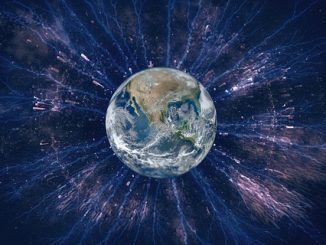One of the things that makes our planet unique among all known bodies in the universe is our kind of atmosphere.
Mercury, the nearest to the Sun, has a very thin one with temperatures reaching up to 800 degrees Fahrenheit.
Venus, on the other hand, which is next to Mercury, has a very thick atmosphere. This, aside from the fact that the planet’s temperature is so hot it can melt lead.
Meanwhile, Mars has a very thin atmosphere composed mostly of carbon dioxide; Jupiter – the gas giant planet – has a layer of gases surrounding it mostly made up of hydrogen gas and helium gas, just like the sun; Neptune’s atmosphere is similar to Jupiter’s with small amount of water and methane that give the planet its brilliant blue color.
Uranus, an ice giant like Neptune, has a layered atmosphere like Earth, but it’s mostly composed of hydrogen and helium and small amount of methane; and, Saturn, which is another gas giant with the most magnificent rings, has an atmosphere similar to Jupiter but it contains more sulfur which gives the planet its orange color.
Earth’s atmosphere is the only one among all the planets that man has ever discovered that’s perfect enough to sustain life.
It is also our primary protection from the Sun’s deadly ultraviolet radiation and more than 100 tons of meteoroids that rain down on our planet everyday.
But, Earth’s atmosphere needs our protection too.
Our atmosphere has different layers:
- From our planet’s surface, this layer extends 8 to 14.5 kilometers high (5 to 9 miles). In this densest part of our atmosphere lies almost all weather that our world experiences.
- Stratosphere. Extending from above the troposphere, this layer reaches up to 50 kilometers (31 miles) high and it is where we’ll also find the ozone layer.
- Extending from above the stratosphere, this layer goes as far as 85 kilometers (53 miles) high where meteors that enter our atmosphere burn.
- Thermosphere. Extending from above the mesosphere, this layer reaches up to 600 kilometers (372 miles) high where the phenomena Aurora Borealis (Northern Lights) and Aurora Australis (Southern Lights) occur as electrons collide with the upper reaches of Earth’s atmosphere. Satellites also orbit in this area.
- Ionosphere. This layer is largely composed of electrons and ionized atoms and molecules that extend from approximately 48 kilometers (30 miles) above the surface to the edge of space at approximately 965 km (600 miles), and overlap into the mesosphere and thermosphere. This layer makes radio communication possible.
- This layer is our atmosphere’s upper limit, which extends from above the thermosphere up to 10,000 km (6,200 miles). It is our planet’s first line of defense against the Sun’s rays and falling objects from outer space.
Over the years, we have been hearing scientists expressing their serious concern about what’s happening to our atmosphere’s ozone layer.
The ozone layer, as already mentioned, is where the Sun’s highly-hazardous ultraviolet radiation is absorbed by ozone molecules. These molecules are very rare, with an average of only about three molecules of ozone for every 10 million air molecules. But on the other hand these ozone molecules have been enough to control enormous amounts of ultraviolet (UV) rays, particularly UV-A and UV-B which can cause skin aging, eye damage (including cataracts), and different types of skin cancer. UV rays can also suppress the immune system, making a person vulnerable to infection and diseases. Worse, they can also cause DNA damage to any living thing and result to DNA malfunction even death.
However, in 1985, Joe Farman, Brian Gardiner and Jonathan Shanklin discovered an unusual depletion of ozone in Antarctica. They published their findings on Nature, which prompted NASA scientists to re-analyzed their satellite data and realize that the whole continent was affected.
Further studies have been conducted by the international research community, and it was learned that the ozone depletion were caused by human-produced chemicals like halocarbons and chlorofluorocarbons (CFCs).
CFCs along with other ozone-depleting gases, carbon tetrachloride and methyl chloroform, have been used in many applications:
- Air conditioning
- Refrigeration
- Foam blowing
- Solvents
- Cleaning of electronics components
The world heeded the warning about the ozone depletion and came up with the Montreal Protocol on Substances that Deplete the Ozone Layer. The international treaty was signed by 197 countries in 1987.
Then, in 2011, it was finally confirmed through monitoring reports that the Earth’s ozone layer was recovering from the negative effects of human-produced chemicals particularly CFCs. The Montreal Protocol has proved to be a successful global action.
But, the challenge is not over.
Even though CFCs had been replaced with hydrofluorocarbons (HFCs) which are nonflammable, recyclable, low-toxic, energy-efficient refrigerants, these are still among the fastest-growing greenhouse gases with “global warming potentials thousands of times higher” than carbon dioxide according to a study by the Berkeley National Laboratory.
The study further reports that countries with emerging economies and fast-growing populations like India, Brazil, and Indonesia are experiencing an air conditioner sales growth of 10 to 15 per cent annually. This means global supply of A/C units could rise from about 900 million in 2015 to around 1.6 billion by 2030.
Such is the need of the world for cooling.
But, at the expense of our atmosphere’s health.
Could there be another effective answer similar to the Montreal Protocol which has succeeded in controlling CFCs?
The answer is in the technology itself via Photonic radiative cooling which is the type of tech that has the potential to cut energy consumption from 10 per cent up to 70 per cent building structures.
Aaswath Raman, one of MIT Technology Review’s “35 Innovators Under 35,” Shanhui Fan, a Stanford professor of electrical engineering, and Eli Goldstein founded the SkyCool Systems, which aims to commercialize the remarkable technology after their in-depth study.
The researchers invented high-tech mirrors that allow a narrow band of sun’s radiation to escape into a cool, upper part of the Earth’s atmosphere. This is made possible by a phenomenon in optics wherein an emission in the mid-infrared range with wavelengths between 8 and 13 micrometers escapes to space. This makes the mirror cooler than its surrounding area. What’s more, the ultra-thin, multi-layered material reflects 97 per cent of the sunlight and lessens incoming heat.
Currently, SkyCool is improving their new invention and evaluating the radiative cooling technology to complement air-conditioning and commercial refrigeration systems. Their next goal is to conduct a large-scale demonstration to motivate possible partners and clients, who have greater cooling needs for things like data centers or supermarkets.
With this new, advanced technology, there’s a brighter hope for the world to significantly reduce its energy consumption through minimal need for air conditioning and cooling systems. What’s more, we can reduce the production of greenhouse gases which cause rising atmospheric and oceanic temperatures. Some people may still deny the fact that we are at the very least, partly responsible for today’s climate change. But we’re thankful that there are still many of us who remain dedicated in pursuing better solutions for a world that’s showing all the signs that it needs help.
Disclaimer: This page contains affiliate links. If you choose to make a purchase after clicking a link, we may receive a commission at no additional cost to you. Thank you for your support!




Leave a Reply